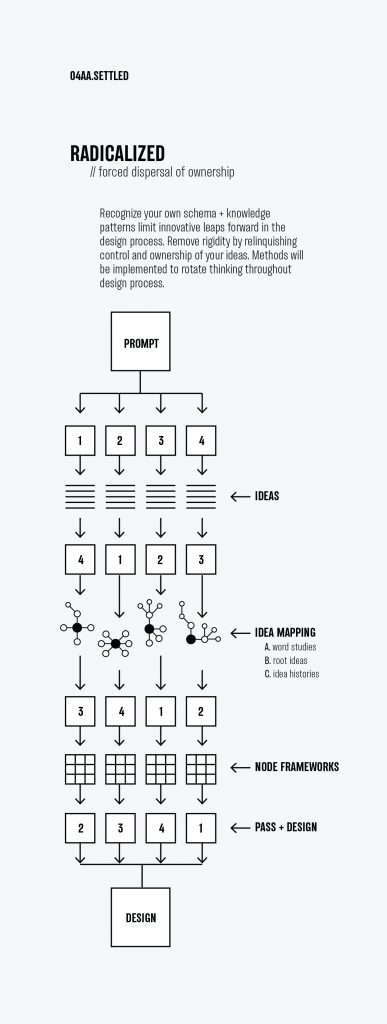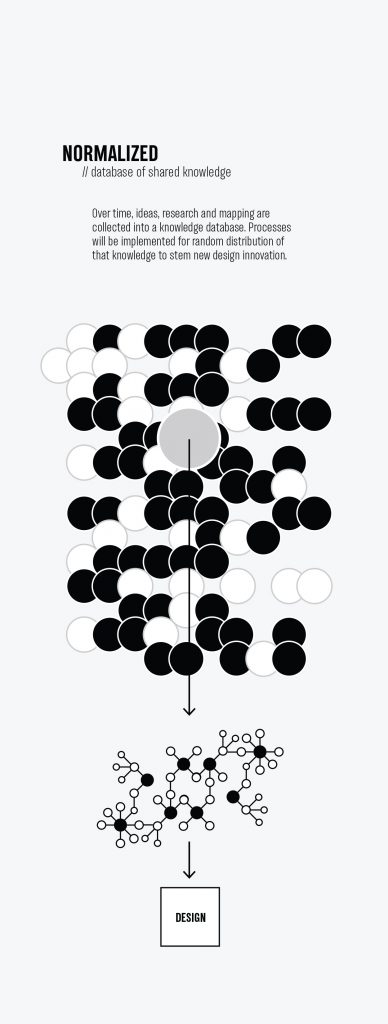We were charged to rethink and redesign (the culture of) graphic design in the context of contemporary practices, application, and usage.
My investigation lead me to look at cultural attitudes of ownership, self-aggrandizement, and control. Is there potential to revolutionize these attitudes to create a space of shared purpose and focused action?
My research lead me to hypothesize that a designer’s schema + knowledge patterns can limit innovative leaps forward in the design process. I propose developing processes that remove this rigidity through the relinquishing of control and ownership of ideas. I began designing methods which would implement the rotation of thinking throughout design process (figure A).

In order to radically introduce these new attitudes, I designed a method of rotation through the design process. Starting with one prompt, each designer would develop one idea and pass it to another designer. That designer would then invest time into researching and mapping concepts surrounding that idea. The mapping would be passed again and this next designer would develop a framework from which to design. One more round of passing and finally a designer would be producing a prototype for the original prompt. The development of the idea would be one that any one of the designers would be unable to produce independently. This process would serve as a creative form of group think.
Designed processes like this have the power to eliminate the overly-emotional, work hoarding, competitive, hierarchical climate in design groups.
As designers become accustomed to such processes, old attitudes will be replaced. A dispersal of ownership will become the norm and designers in groups will no longer work in a state of fear that someone might steal an idea, get the best opportunity, or win the favor. Creativity and flow of information will serve everyone equally – and result in richer design.
Ideas, research, and mapping will be collected into a knowledge database. Processes will then be implemented for random distribution of that knowledge to stem new design innovation (figure B).

I designed a prototype of an interface for the Radicalized condition. This would be a remote-access co-working space that forcefully eliminates the ownership of ideas. The space will have a set of rules, ethics, and customs, and will implement Robert’s Rules of Orders to bring certain motions before the group such as “randomly rotate artboards” amongst members, to all “join on one design”, or to “request additional project information”.

Here is a sample interface I designed for the Normalized condition. The goal of the software, NODE, will be to take the ego out of ideas. A user will have the opportunity to both give and take from the knowledge database. A user will start a new project by following a set of prompts and sifting through collected ideas.
 As designers, can we create deliberate processes that grant continued creative pursuit, allowing space for ideas to unfold? I believe we can. I believe there is unlimited potential in trying to do so. If even one designer is influence to transition their thinking from “I need to have all the answers” to “my curiosity will spark creative ideas in others”, then we are surely moving the culture of graphic design in the right direction.
As designers, can we create deliberate processes that grant continued creative pursuit, allowing space for ideas to unfold? I believe we can. I believe there is unlimited potential in trying to do so. If even one designer is influence to transition their thinking from “I need to have all the answers” to “my curiosity will spark creative ideas in others”, then we are surely moving the culture of graphic design in the right direction.

